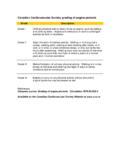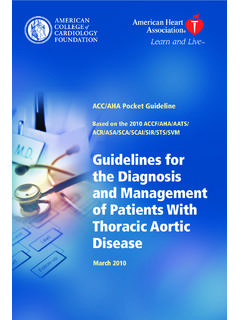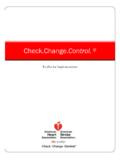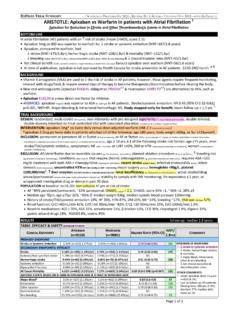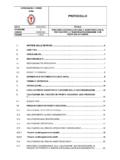Transcription of Canadian Cardiovascular Society Working Group: …
1 Can J Cardiol Vol 25 No 1 January 200925 Canadian Cardiovascular Society Working group : Providing a perspective on the 2007 focused update of the american College of Cardiology and american Heart Association 2004 guidelines for the management of ST elevation myocardial infarctionRobert C Welsh MD FRCPC1, Andrew Travers MD2, Thao Huynh MD3, Warren J Cantor MD4,51 University of Alberta, Edmonton, Alberta; 2 Dalhousie University, Halifax, Nova Scotia; 3 McGill University Health Centre, Montreal, Quebec; 4 Southlake Regional Health Centre, Newmarket; 5 University of Toronto, Toronto, OntarioCorrespondence: Dr Robert C Welsh, Department of Medicine, University of Alberta, 2C2 Cardiology WMC, 8440 112 Street Northwest, Edmonton, Alberta T6G 2B7. Telephone 780-407-3613, fax 780-407-3639, e-mail for publication September 24, 2008.
2 Accepted October 20, 2008 PreambleIn 2004, the american College of Cardiology (ACC) and american Heart Association (AHA) task force on practice guidelines undertook a comprehensive rewriting of the ST elevation myocardial infarction (STEMI) guidelines (1). The Canadian Cardiovascular Society (CCS) collaborated on these guidelines and a Working group from the CCS provided a Canadian perspective and adaptation (2). In late 2007, a focused update of the ACC/AHA 2004 STEMI guidelines was published to address new evidence from recent publica-tions and presentations at major scientific meetings, consistent with the ACC/AHA practice guidelines committee s desire to continue maintaining the existing guidelines at the highest scientific level (3). This process was also completed in collaboration with the CCS, with involvement from Dr Paul Armstrong on the writing group committee as well as through independent review (RC Welsh).
3 A Canadian Working group (CWG) was formed under the auspice of the CCS to provide interpretation and, where appropriate, adapta-tion of the focused guidelines update to fit the specific geographical and health economic issues in the Canadian health care system. The CWG was selected to provide adequate representation from major geographical regions within the nation, both community and aca-demic thought leadership, representation from interventional and noninterventional cardiologists, as well as the addition of an emer-gency medicine physician with emergency medical services (EMS) leadership in prehospital care. IntroductIonDue to the arduous task of reviewing all available information regard-ing the management of STEMI patients and obtaining consensus from a group of leading experts, guidelines are frequently outdated soon after their formal publication.
4 In an attempt to manage these issues, the ACC/AHA task force on practice guidelines has created a focused update process to revise existing guidelines. The approach to this task is well described elsewhere but, in brief, involves a review of key peer-reviewed publications not included in the full guidelines and a review of late-breaking clinical trial presentations at major academic cardiol-ogy meetings, including the congresses of the ACC, AHA and European Society of Cardiology (3). The focused update and full guidelines are intended to assist health care providers and clinical decision makers by describing a range of generally acceptable approaches for the diagnosis, management and prevention of specific diseases or conditions.
5 They attempt to define practices that meet the needs of most patients and circumstances. The ultimate judgment regarding care of a particular patient must be made by the health care provider and patient in light of all the circumstances presented by both that patient and the existing health care system. Consistent with the available evidence, the majority of the 2007 focused update content is related to new information about analgesics, utilization of beta-blockers, and fibrinolysis-conjunctive antithrombotic and antiplatelet agents. Further evidence regarding the approach to mechanical cointervention following reperfusion with fibrinolysis were also incorporated, addressing facilitated percutaneous coronary inter-vention (PCI), rescue PCI and the use of coronary angiography in stable patients following fibrinolysis.
6 Despite a great attempt to stay up to date on current evidence, several key trials in STEMI patients have been published or presented since the 2007 focused update was is recognized that the implementation of guidelines must con-sider the quality and availability of expertise in the area in which care is being provided, and must be specific to the Canadian health care system. The present CWG document will focus on a practical summary of the 2007 focused update of the ACC/AHA STEMI guidelines, with directed comments when appropriate and further discussion regarding the notion of first medical contact, systems approaches to STEMI care (a topic in which Canada has provided leadership), appropriate transfer of remote patients to tertiary care PCI centres for primary, rescue and elective PCI, and the importance of continuous quality improvement programs within the Canadian health care environment.
7 The CWG does not intend for the present document to cover the spectrum of issues related to STEMI. For that, we refer our colleagues to the complete 2004 ACC/AHA STEMI guidelines and the 2007 focused update to which we are providing the present perspective (1,3). Key hIghlIghts from the 2007 acc/aha focused uPdate of stemI guIdelInesThe following seven points summarize the key highlights that were presented in the 2007 ACC/AHA focused update of STEMI guide-lines. When appropriate, the CWG has provided a perspective or adaptation (identified in italics).With the exception of acetylsalicylic acid (ASA), both nonselective and cyclooxygenase-2-selective nonsteroidal anti-inflammatory drugs have been associated with increased risk of mortality, reinfarction, hypertension, heart failure and myocardial rupture (3).
8 Therefore, patients presenting with STEMI who are routinely taking nonsteroidal anti-inflammatory agents should immediately discontinue taking these drugs. For those requiring ongoing therapy for pain, ASA and/or morphine sulphate are appropriate alternatives. Canadian Cardiovascular Society PerSPeCTive 2009 Pulsus group Inc. All rights reservedWelsh et alCan J Cardiol Vol 25 No 1 January 200926 Early aggressive beta-blocker therapy (intravenous and oral) was not associated with clinical benefit but was actually associated with increased risk when delivered to a broad spectrum of STEMI patients within the ClOpidogrel and Metoprolol in Myocardial Infarction Trial (COMMIT) II (4). Evidence still supports the initiation of oral beta-blocker therapies within the first 24 h from diagnosis in patients who do not have signs of heart failure, low output states, increased risk for cardiogenic shock or other relative contraindications for beta-blockers (first-, second- or third-degree heart block, active asthma or reactive airway disease).
9 Beta-blockers should be initiated at low to moderate doses and titrated consistent with patient stability, heart rate and blood pressure response. Intravenous beta-blockers maintain clinical utility in selected patient populations, especially those with ongoing myocardial ischemia associated with significant hypertension and in the absence of high-risk features for congestive heart failure or cardiogenic goals for the treatment of STEMI include achieving a time to reperfusion (measured from first medical contact) of 90 min for primary PCI and 30 min for fibrinolysis, both of which represent the longest time that should be considered, rather than the ideal time (3,5). STEMI patients presenting to a hospital that is incapable of achieving primary PCI within 90 min of first medical contact should administer fibrinolysis within 30 min with a proviso that those with absolute or relative contraindications to fibrinolytic therapy may appropriately be referred for primary PCI, accepting longer delays (although intervention should occur as rapidly as possible).
10 The update discouraged a strategy of routine immediate cardiac catheterization following administration of fibrinolysis except for patients with cardiogenic shock, severe congestive heart failure and/or pulmonary edema, or hemodynamic compromising ventricular arrhythmias refractory to medical therapy. However, this point will be further discussed in the context of recent scientific undergoing reperfusion with fibrinolysis should receive anticoagulation therapy for a minimum of 48 h and, preferably, for the duration of the index hospitalization, with evidence supporting the use of enoxaparin administered according to the EnoXaparin and Thrombolysis Reperfusion for Acute Myocardial Infarction Treatment (EXTRACT) Thrombolysis in Myocardial Infarction 25 (EXTRACT-TIMI 25) study protocol (6).

